Supplier Collaboration Using Drama Theory
VerifiedAdded on 2020/02/24
|13
|3368
|40
AI Summary
This assignment explores the application of drama theory to improve supplier collaboration within a supply chain management context. Students are tasked with analyzing how theatrical elements like character roles, narratives, and conflict resolution can be leveraged to foster effective communication, trust, and cooperation between suppliers and other stakeholders in the supply chain.
Contribute Materials
Your contribution can guide someone’s learning journey. Share your
documents today.
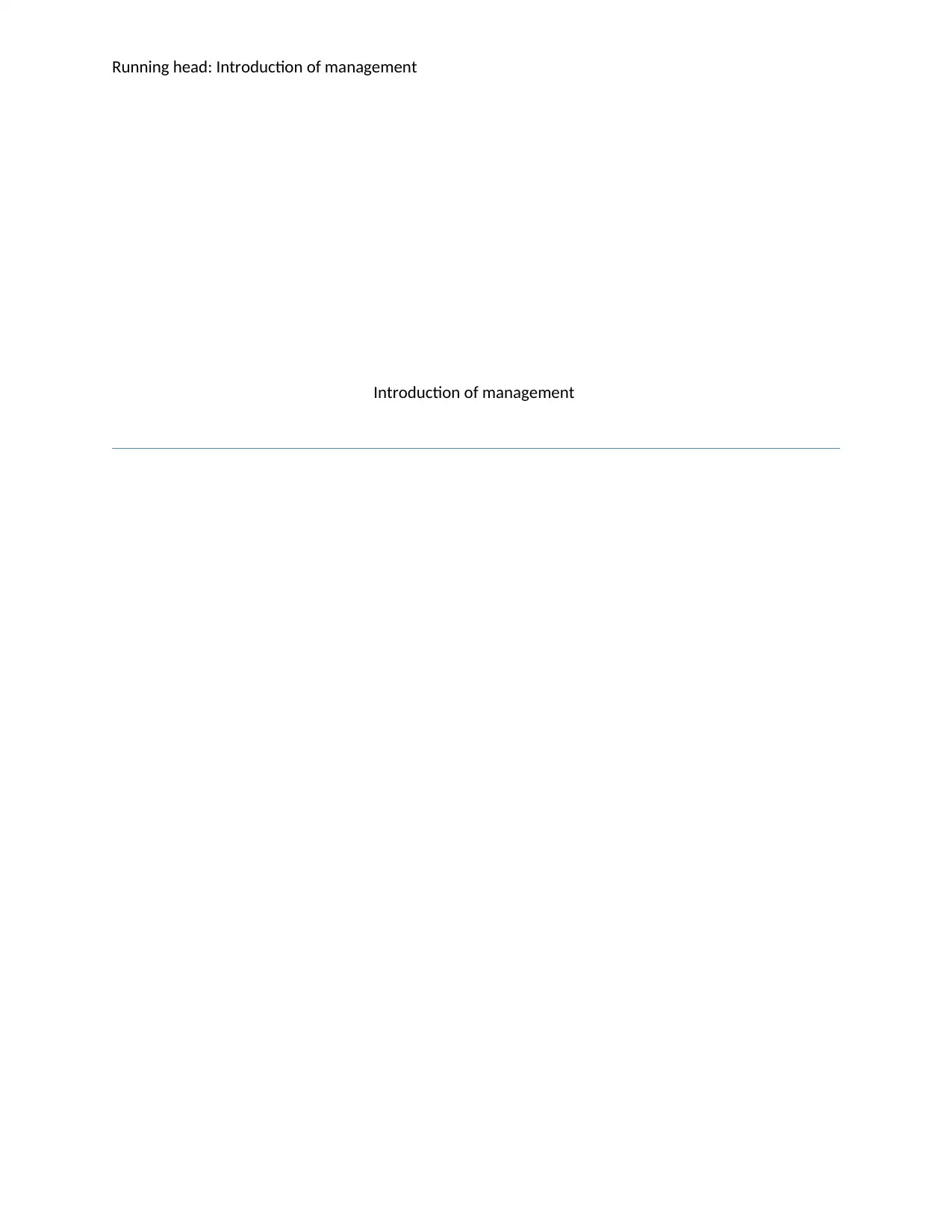
Running head: Introduction of management
Introduction of management
Introduction of management
Secure Best Marks with AI Grader
Need help grading? Try our AI Grader for instant feedback on your assignments.
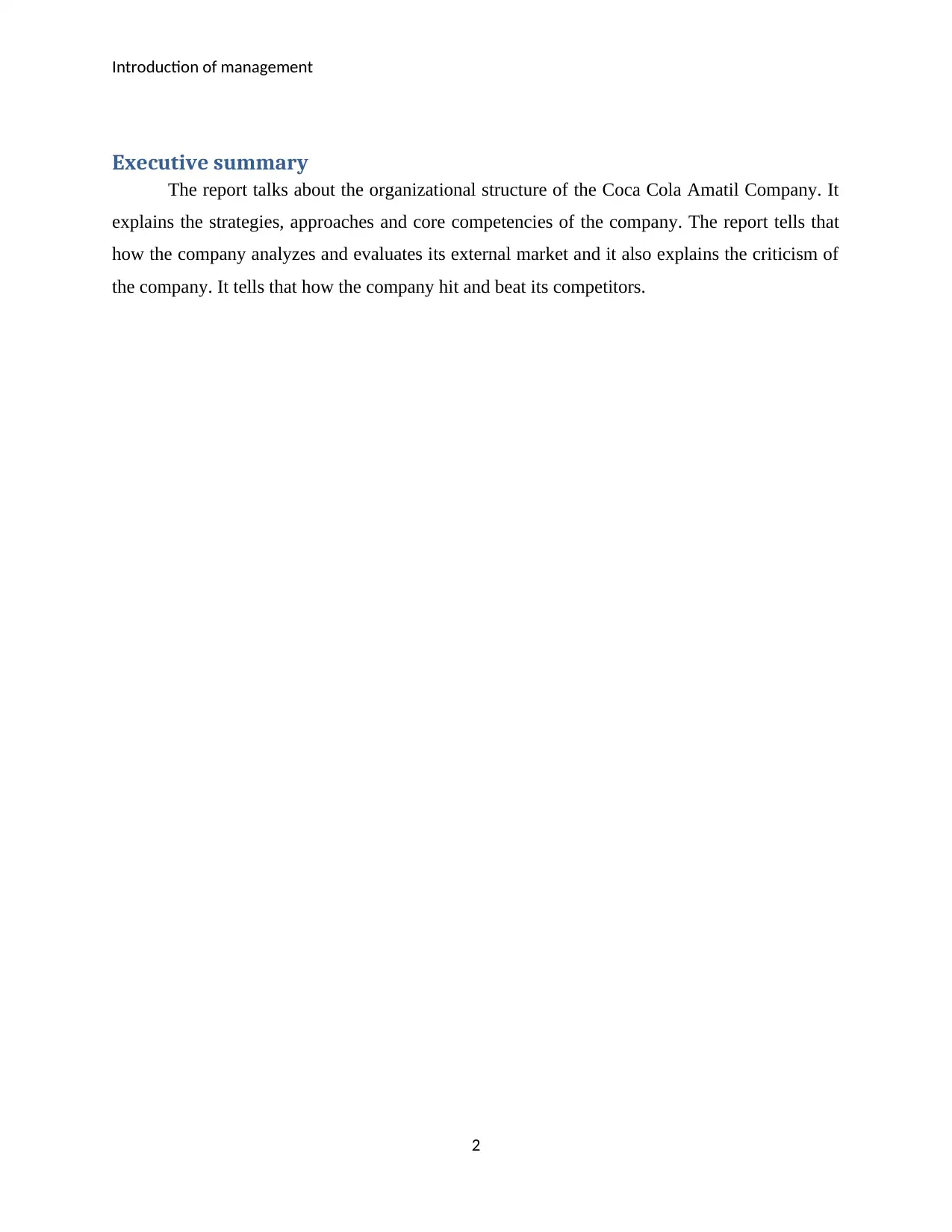
Introduction of management
Executive summary
The report talks about the organizational structure of the Coca Cola Amatil Company. It
explains the strategies, approaches and core competencies of the company. The report tells that
how the company analyzes and evaluates its external market and it also explains the criticism of
the company. It tells that how the company hit and beat its competitors.
2
Executive summary
The report talks about the organizational structure of the Coca Cola Amatil Company. It
explains the strategies, approaches and core competencies of the company. The report tells that
how the company analyzes and evaluates its external market and it also explains the criticism of
the company. It tells that how the company hit and beat its competitors.
2
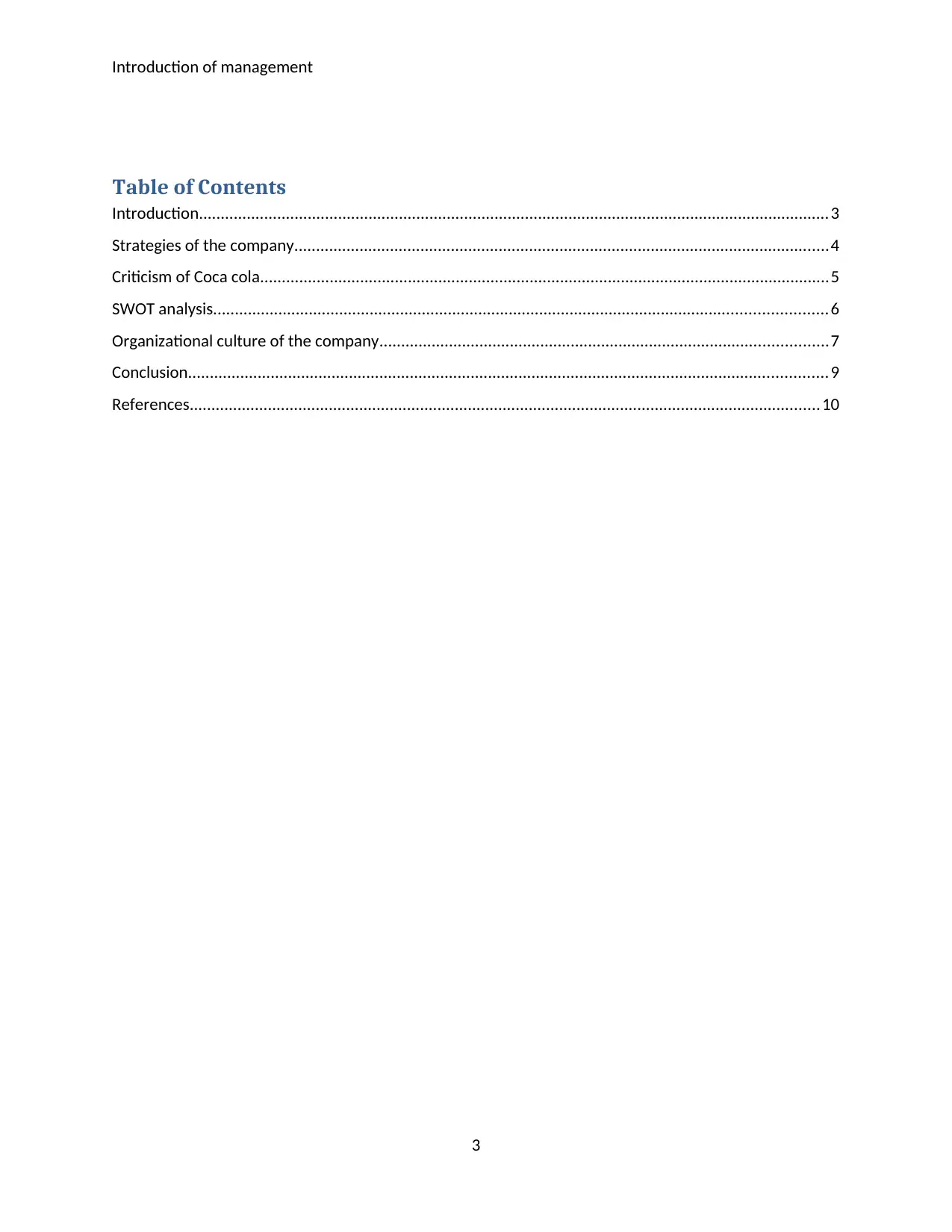
Introduction of management
Table of Contents
Introduction.................................................................................................................................................3
Strategies of the company...........................................................................................................................4
Criticism of Coca cola...................................................................................................................................5
SWOT analysis.............................................................................................................................................6
Organizational culture of the company.......................................................................................................7
Conclusion...................................................................................................................................................9
References.................................................................................................................................................10
3
Table of Contents
Introduction.................................................................................................................................................3
Strategies of the company...........................................................................................................................4
Criticism of Coca cola...................................................................................................................................5
SWOT analysis.............................................................................................................................................6
Organizational culture of the company.......................................................................................................7
Conclusion...................................................................................................................................................9
References.................................................................................................................................................10
3
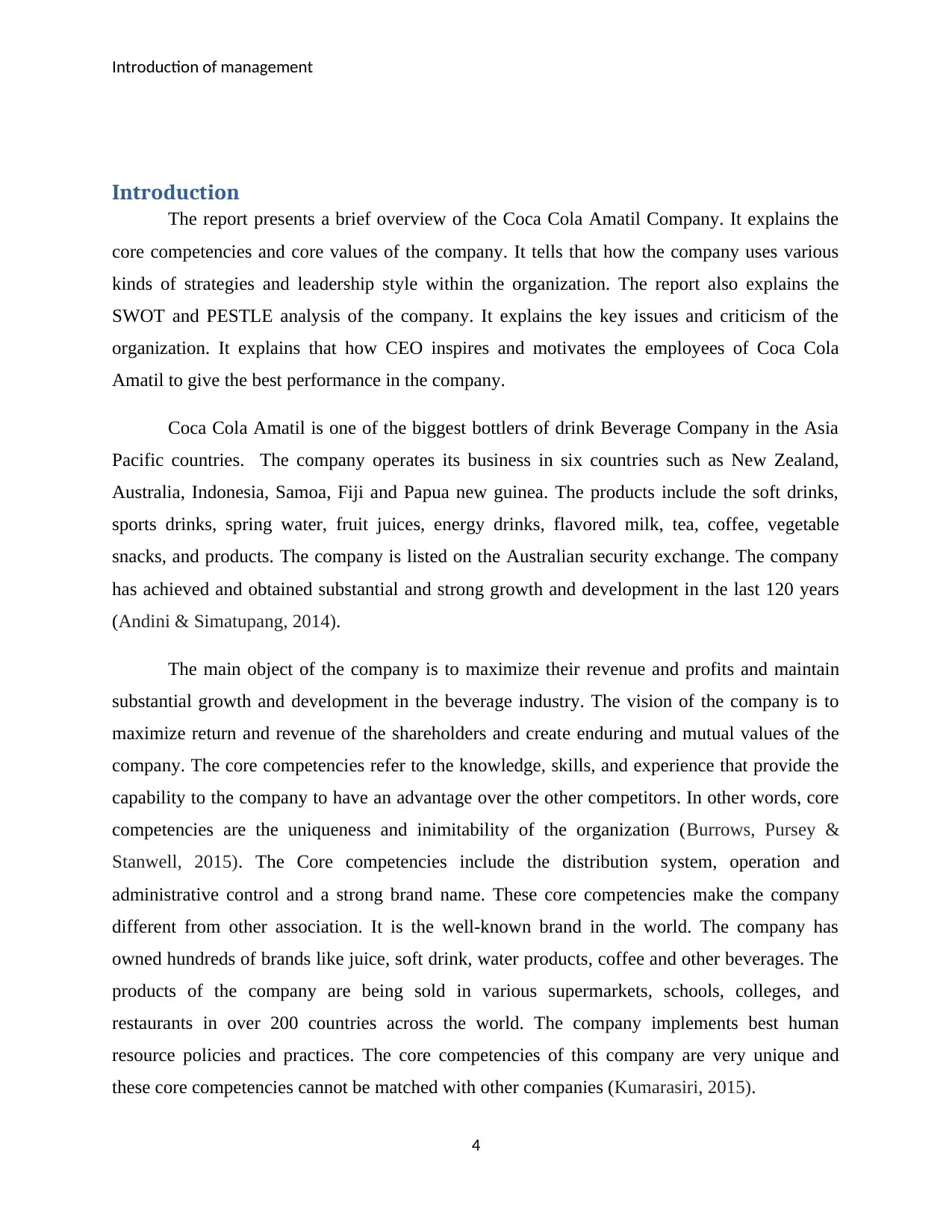
Introduction of management
Introduction
The report presents a brief overview of the Coca Cola Amatil Company. It explains the
core competencies and core values of the company. It tells that how the company uses various
kinds of strategies and leadership style within the organization. The report also explains the
SWOT and PESTLE analysis of the company. It explains the key issues and criticism of the
organization. It explains that how CEO inspires and motivates the employees of Coca Cola
Amatil to give the best performance in the company.
Coca Cola Amatil is one of the biggest bottlers of drink Beverage Company in the Asia
Pacific countries. The company operates its business in six countries such as New Zealand,
Australia, Indonesia, Samoa, Fiji and Papua new guinea. The products include the soft drinks,
sports drinks, spring water, fruit juices, energy drinks, flavored milk, tea, coffee, vegetable
snacks, and products. The company is listed on the Australian security exchange. The company
has achieved and obtained substantial and strong growth and development in the last 120 years
(Andini & Simatupang, 2014).
The main object of the company is to maximize their revenue and profits and maintain
substantial growth and development in the beverage industry. The vision of the company is to
maximize return and revenue of the shareholders and create enduring and mutual values of the
company. The core competencies refer to the knowledge, skills, and experience that provide the
capability to the company to have an advantage over the other competitors. In other words, core
competencies are the uniqueness and inimitability of the organization (Burrows, Pursey &
Stanwell, 2015). The Core competencies include the distribution system, operation and
administrative control and a strong brand name. These core competencies make the company
different from other association. It is the well-known brand in the world. The company has
owned hundreds of brands like juice, soft drink, water products, coffee and other beverages. The
products of the company are being sold in various supermarkets, schools, colleges, and
restaurants in over 200 countries across the world. The company implements best human
resource policies and practices. The core competencies of this company are very unique and
these core competencies cannot be matched with other companies (Kumarasiri, 2015).
4
Introduction
The report presents a brief overview of the Coca Cola Amatil Company. It explains the
core competencies and core values of the company. It tells that how the company uses various
kinds of strategies and leadership style within the organization. The report also explains the
SWOT and PESTLE analysis of the company. It explains the key issues and criticism of the
organization. It explains that how CEO inspires and motivates the employees of Coca Cola
Amatil to give the best performance in the company.
Coca Cola Amatil is one of the biggest bottlers of drink Beverage Company in the Asia
Pacific countries. The company operates its business in six countries such as New Zealand,
Australia, Indonesia, Samoa, Fiji and Papua new guinea. The products include the soft drinks,
sports drinks, spring water, fruit juices, energy drinks, flavored milk, tea, coffee, vegetable
snacks, and products. The company is listed on the Australian security exchange. The company
has achieved and obtained substantial and strong growth and development in the last 120 years
(Andini & Simatupang, 2014).
The main object of the company is to maximize their revenue and profits and maintain
substantial growth and development in the beverage industry. The vision of the company is to
maximize return and revenue of the shareholders and create enduring and mutual values of the
company. The core competencies refer to the knowledge, skills, and experience that provide the
capability to the company to have an advantage over the other competitors. In other words, core
competencies are the uniqueness and inimitability of the organization (Burrows, Pursey &
Stanwell, 2015). The Core competencies include the distribution system, operation and
administrative control and a strong brand name. These core competencies make the company
different from other association. It is the well-known brand in the world. The company has
owned hundreds of brands like juice, soft drink, water products, coffee and other beverages. The
products of the company are being sold in various supermarkets, schools, colleges, and
restaurants in over 200 countries across the world. The company implements best human
resource policies and practices. The core competencies of this company are very unique and
these core competencies cannot be matched with other companies (Kumarasiri, 2015).
4
Secure Best Marks with AI Grader
Need help grading? Try our AI Grader for instant feedback on your assignments.
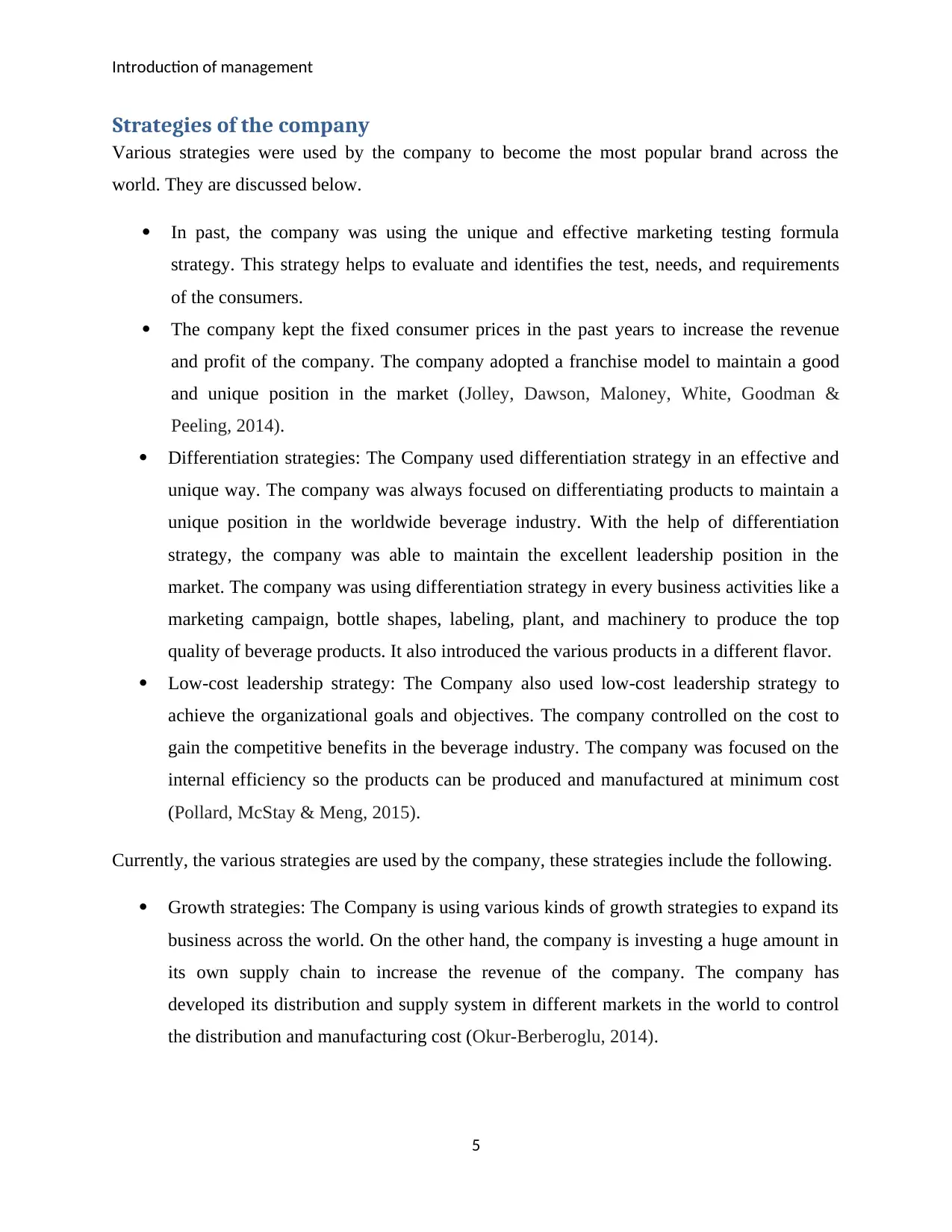
Introduction of management
Strategies of the company
Various strategies were used by the company to become the most popular brand across the
world. They are discussed below.
In past, the company was using the unique and effective marketing testing formula
strategy. This strategy helps to evaluate and identifies the test, needs, and requirements
of the consumers.
The company kept the fixed consumer prices in the past years to increase the revenue
and profit of the company. The company adopted a franchise model to maintain a good
and unique position in the market (Jolley, Dawson, Maloney, White, Goodman &
Peeling, 2014).
Differentiation strategies: The Company used differentiation strategy in an effective and
unique way. The company was always focused on differentiating products to maintain a
unique position in the worldwide beverage industry. With the help of differentiation
strategy, the company was able to maintain the excellent leadership position in the
market. The company was using differentiation strategy in every business activities like a
marketing campaign, bottle shapes, labeling, plant, and machinery to produce the top
quality of beverage products. It also introduced the various products in a different flavor.
Low-cost leadership strategy: The Company also used low-cost leadership strategy to
achieve the organizational goals and objectives. The company controlled on the cost to
gain the competitive benefits in the beverage industry. The company was focused on the
internal efficiency so the products can be produced and manufactured at minimum cost
(Pollard, McStay & Meng, 2015).
Currently, the various strategies are used by the company, these strategies include the following.
Growth strategies: The Company is using various kinds of growth strategies to expand its
business across the world. On the other hand, the company is investing a huge amount in
its own supply chain to increase the revenue of the company. The company has
developed its distribution and supply system in different markets in the world to control
the distribution and manufacturing cost (Okur-Berberoglu, 2014).
5
Strategies of the company
Various strategies were used by the company to become the most popular brand across the
world. They are discussed below.
In past, the company was using the unique and effective marketing testing formula
strategy. This strategy helps to evaluate and identifies the test, needs, and requirements
of the consumers.
The company kept the fixed consumer prices in the past years to increase the revenue
and profit of the company. The company adopted a franchise model to maintain a good
and unique position in the market (Jolley, Dawson, Maloney, White, Goodman &
Peeling, 2014).
Differentiation strategies: The Company used differentiation strategy in an effective and
unique way. The company was always focused on differentiating products to maintain a
unique position in the worldwide beverage industry. With the help of differentiation
strategy, the company was able to maintain the excellent leadership position in the
market. The company was using differentiation strategy in every business activities like a
marketing campaign, bottle shapes, labeling, plant, and machinery to produce the top
quality of beverage products. It also introduced the various products in a different flavor.
Low-cost leadership strategy: The Company also used low-cost leadership strategy to
achieve the organizational goals and objectives. The company controlled on the cost to
gain the competitive benefits in the beverage industry. The company was focused on the
internal efficiency so the products can be produced and manufactured at minimum cost
(Pollard, McStay & Meng, 2015).
Currently, the various strategies are used by the company, these strategies include the following.
Growth strategies: The Company is using various kinds of growth strategies to expand its
business across the world. On the other hand, the company is investing a huge amount in
its own supply chain to increase the revenue of the company. The company has
developed its distribution and supply system in different markets in the world to control
the distribution and manufacturing cost (Okur-Berberoglu, 2014).
5
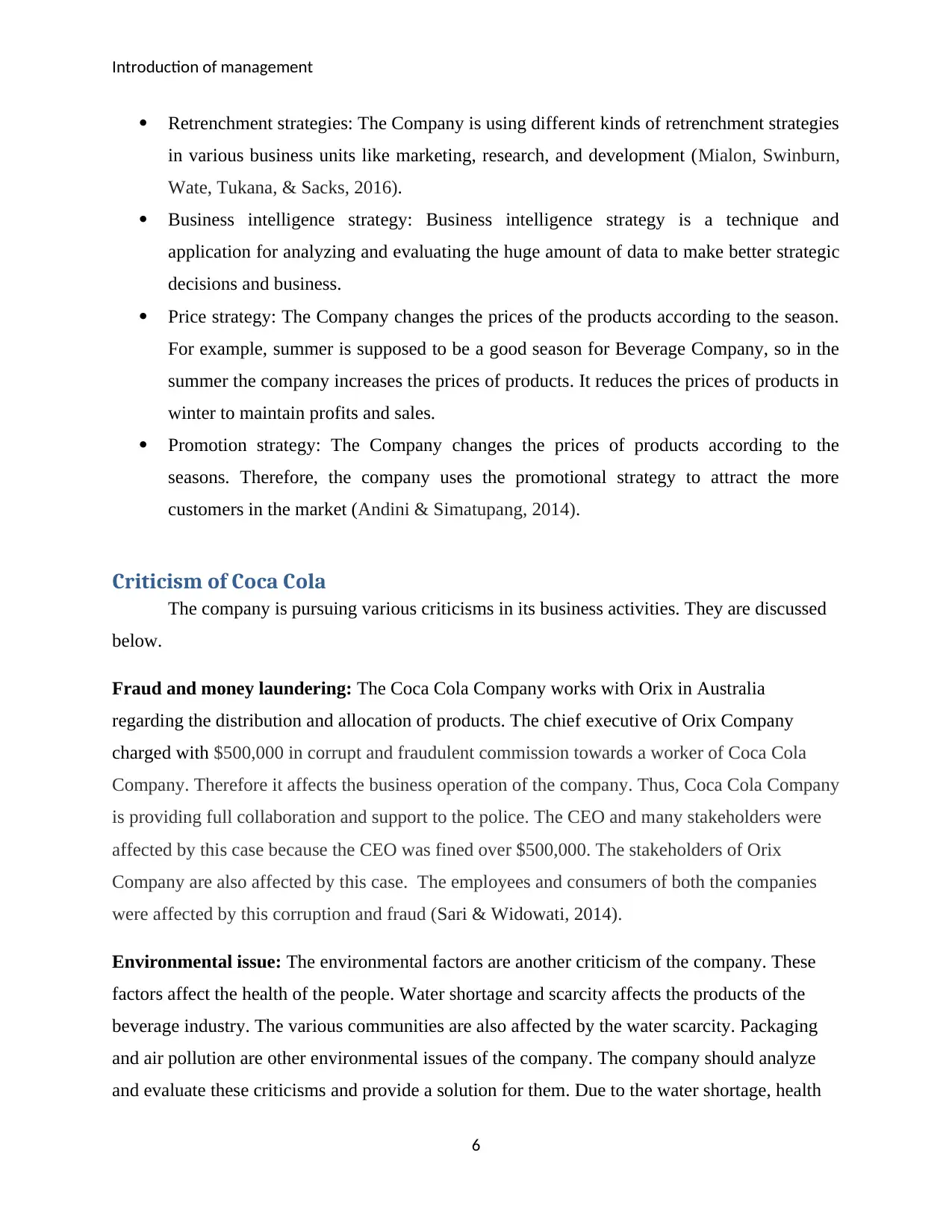
Introduction of management
Retrenchment strategies: The Company is using different kinds of retrenchment strategies
in various business units like marketing, research, and development (Mialon, Swinburn,
Wate, Tukana, & Sacks, 2016).
Business intelligence strategy: Business intelligence strategy is a technique and
application for analyzing and evaluating the huge amount of data to make better strategic
decisions and business.
Price strategy: The Company changes the prices of the products according to the season.
For example, summer is supposed to be a good season for Beverage Company, so in the
summer the company increases the prices of products. It reduces the prices of products in
winter to maintain profits and sales.
Promotion strategy: The Company changes the prices of products according to the
seasons. Therefore, the company uses the promotional strategy to attract the more
customers in the market (Andini & Simatupang, 2014).
Criticism of Coca Cola
The company is pursuing various criticisms in its business activities. They are discussed
below.
Fraud and money laundering: The Coca Cola Company works with Orix in Australia
regarding the distribution and allocation of products. The chief executive of Orix Company
charged with $500,000 in corrupt and fraudulent commission towards a worker of Coca Cola
Company. Therefore it affects the business operation of the company. Thus, Coca Cola Company
is providing full collaboration and support to the police. The CEO and many stakeholders were
affected by this case because the CEO was fined over $500,000. The stakeholders of Orix
Company are also affected by this case. The employees and consumers of both the companies
were affected by this corruption and fraud (Sari & Widowati, 2014).
Environmental issue: The environmental factors are another criticism of the company. These
factors affect the health of the people. Water shortage and scarcity affects the products of the
beverage industry. The various communities are also affected by the water scarcity. Packaging
and air pollution are other environmental issues of the company. The company should analyze
and evaluate these criticisms and provide a solution for them. Due to the water shortage, health
6
Retrenchment strategies: The Company is using different kinds of retrenchment strategies
in various business units like marketing, research, and development (Mialon, Swinburn,
Wate, Tukana, & Sacks, 2016).
Business intelligence strategy: Business intelligence strategy is a technique and
application for analyzing and evaluating the huge amount of data to make better strategic
decisions and business.
Price strategy: The Company changes the prices of the products according to the season.
For example, summer is supposed to be a good season for Beverage Company, so in the
summer the company increases the prices of products. It reduces the prices of products in
winter to maintain profits and sales.
Promotion strategy: The Company changes the prices of products according to the
seasons. Therefore, the company uses the promotional strategy to attract the more
customers in the market (Andini & Simatupang, 2014).
Criticism of Coca Cola
The company is pursuing various criticisms in its business activities. They are discussed
below.
Fraud and money laundering: The Coca Cola Company works with Orix in Australia
regarding the distribution and allocation of products. The chief executive of Orix Company
charged with $500,000 in corrupt and fraudulent commission towards a worker of Coca Cola
Company. Therefore it affects the business operation of the company. Thus, Coca Cola Company
is providing full collaboration and support to the police. The CEO and many stakeholders were
affected by this case because the CEO was fined over $500,000. The stakeholders of Orix
Company are also affected by this case. The employees and consumers of both the companies
were affected by this corruption and fraud (Sari & Widowati, 2014).
Environmental issue: The environmental factors are another criticism of the company. These
factors affect the health of the people. Water shortage and scarcity affects the products of the
beverage industry. The various communities are also affected by the water scarcity. Packaging
and air pollution are other environmental issues of the company. The company should analyze
and evaluate these criticisms and provide a solution for them. Due to the water shortage, health
6
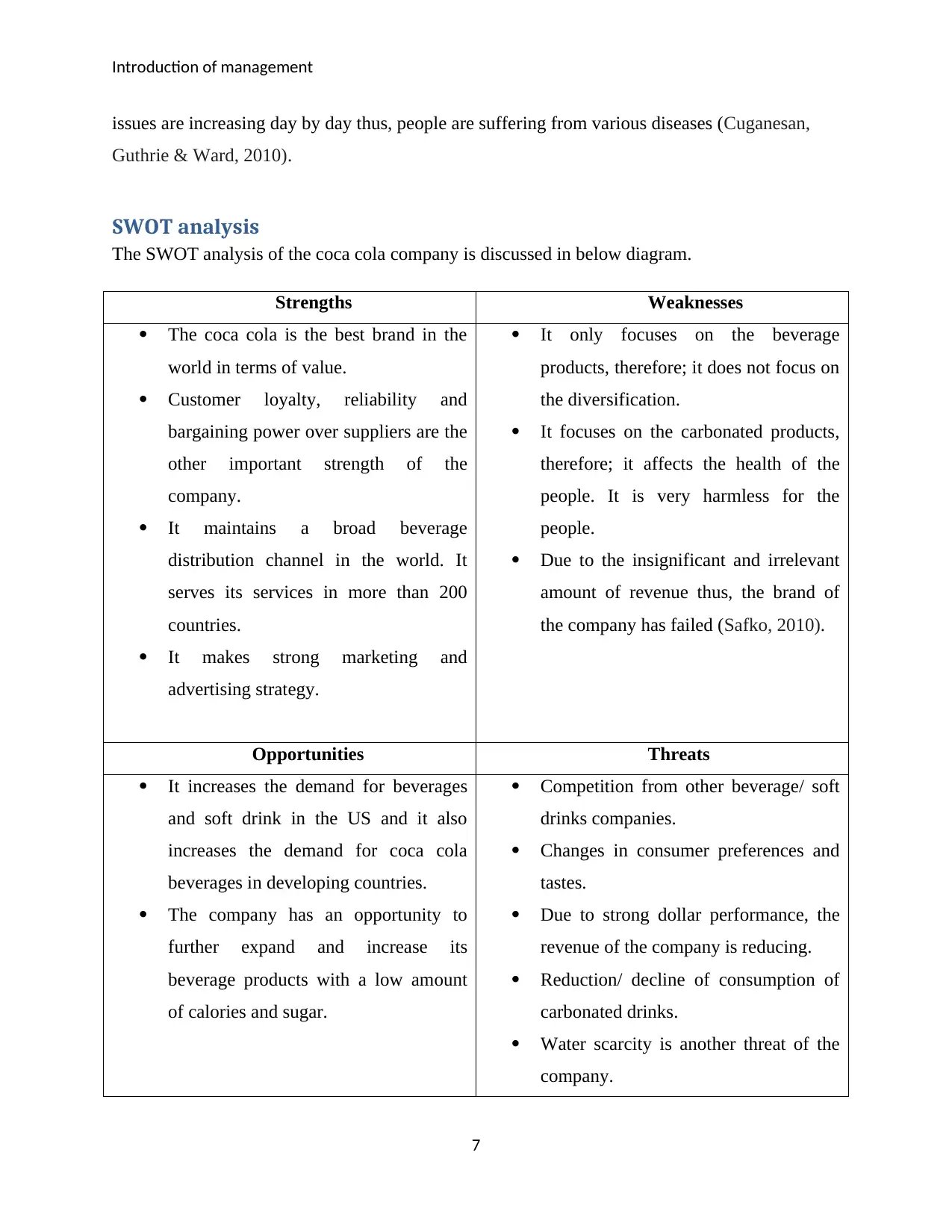
Introduction of management
issues are increasing day by day thus, people are suffering from various diseases (Cuganesan,
Guthrie & Ward, 2010).
SWOT analysis
The SWOT analysis of the coca cola company is discussed in below diagram.
Strengths Weaknesses
The coca cola is the best brand in the
world in terms of value.
Customer loyalty, reliability and
bargaining power over suppliers are the
other important strength of the
company.
It maintains a broad beverage
distribution channel in the world. It
serves its services in more than 200
countries.
It makes strong marketing and
advertising strategy.
It only focuses on the beverage
products, therefore; it does not focus on
the diversification.
It focuses on the carbonated products,
therefore; it affects the health of the
people. It is very harmless for the
people.
Due to the insignificant and irrelevant
amount of revenue thus, the brand of
the company has failed (Safko, 2010).
Opportunities Threats
It increases the demand for beverages
and soft drink in the US and it also
increases the demand for coca cola
beverages in developing countries.
The company has an opportunity to
further expand and increase its
beverage products with a low amount
of calories and sugar.
Competition from other beverage/ soft
drinks companies.
Changes in consumer preferences and
tastes.
Due to strong dollar performance, the
revenue of the company is reducing.
Reduction/ decline of consumption of
carbonated drinks.
Water scarcity is another threat of the
company.
7
issues are increasing day by day thus, people are suffering from various diseases (Cuganesan,
Guthrie & Ward, 2010).
SWOT analysis
The SWOT analysis of the coca cola company is discussed in below diagram.
Strengths Weaknesses
The coca cola is the best brand in the
world in terms of value.
Customer loyalty, reliability and
bargaining power over suppliers are the
other important strength of the
company.
It maintains a broad beverage
distribution channel in the world. It
serves its services in more than 200
countries.
It makes strong marketing and
advertising strategy.
It only focuses on the beverage
products, therefore; it does not focus on
the diversification.
It focuses on the carbonated products,
therefore; it affects the health of the
people. It is very harmless for the
people.
Due to the insignificant and irrelevant
amount of revenue thus, the brand of
the company has failed (Safko, 2010).
Opportunities Threats
It increases the demand for beverages
and soft drink in the US and it also
increases the demand for coca cola
beverages in developing countries.
The company has an opportunity to
further expand and increase its
beverage products with a low amount
of calories and sugar.
Competition from other beverage/ soft
drinks companies.
Changes in consumer preferences and
tastes.
Due to strong dollar performance, the
revenue of the company is reducing.
Reduction/ decline of consumption of
carbonated drinks.
Water scarcity is another threat of the
company.
7
Paraphrase This Document
Need a fresh take? Get an instant paraphrase of this document with our AI Paraphraser

Introduction of management
The Coca Cola is the beverage production company and it serves its customers across the
world. It is one of the most valuable brands which is known as globally. The macro
environmental factors affect the business of the company. PepsiCo, Nudie Foods Australia,
Schweppes Kirks, Golden Circle, Bundaberg, Saxbys, and Heinz are the main competitors of
Coca Cola Amatil Company. Therefore, the company needs to be focused on the business
activities of competitors. The PESTLE analysis of the company is discussed below.
Political factors: The political factors affect the business activities of the company. The political
factors include the labor laws. Internal marketing and taxes widely affect the operation and
business of the company.
Economic factors: The Company serves its various products in different countries around the
world. The different region has different customs, cultures, tastes, and desires. Therefore, all
these economic factors affect the business activities of the company (Handayati, Simatupang &
Sridharan, 2010).
Social factors: The demand for carbonated beverages is reducing, therefore, income and revenue
of the company is also decreasing. The consumers’ social values and lifestyle also affect the
operation of the company.
Technology factors: The Company analyzes and evaluates the technology factors of the
company. The company needs excellent machinery which is helpful in manufacturing and
production of excellent quality of products. The company uses social media to maintain a better
relationship with customers (Klimes, Janda, Ibalim, Kua & Novotny, 2011).
Legal factors: The Coca Cola Company acquires all the rights of the business activities which
include the past and future products. Therefore, the company evaluates the legal factors.
Environmental factors: The environmental factors also affect the business operation of the
company. Water is mandatory for soft drinks and beverage products. Weather and climate affect
the soft drink industry. Water accessibility is another issue in Beverage Company (Hill, 2010).
8
The Coca Cola is the beverage production company and it serves its customers across the
world. It is one of the most valuable brands which is known as globally. The macro
environmental factors affect the business of the company. PepsiCo, Nudie Foods Australia,
Schweppes Kirks, Golden Circle, Bundaberg, Saxbys, and Heinz are the main competitors of
Coca Cola Amatil Company. Therefore, the company needs to be focused on the business
activities of competitors. The PESTLE analysis of the company is discussed below.
Political factors: The political factors affect the business activities of the company. The political
factors include the labor laws. Internal marketing and taxes widely affect the operation and
business of the company.
Economic factors: The Company serves its various products in different countries around the
world. The different region has different customs, cultures, tastes, and desires. Therefore, all
these economic factors affect the business activities of the company (Handayati, Simatupang &
Sridharan, 2010).
Social factors: The demand for carbonated beverages is reducing, therefore, income and revenue
of the company is also decreasing. The consumers’ social values and lifestyle also affect the
operation of the company.
Technology factors: The Company analyzes and evaluates the technology factors of the
company. The company needs excellent machinery which is helpful in manufacturing and
production of excellent quality of products. The company uses social media to maintain a better
relationship with customers (Klimes, Janda, Ibalim, Kua & Novotny, 2011).
Legal factors: The Coca Cola Company acquires all the rights of the business activities which
include the past and future products. Therefore, the company evaluates the legal factors.
Environmental factors: The environmental factors also affect the business operation of the
company. Water is mandatory for soft drinks and beverage products. Weather and climate affect
the soft drink industry. Water accessibility is another issue in Beverage Company (Hill, 2010).
8
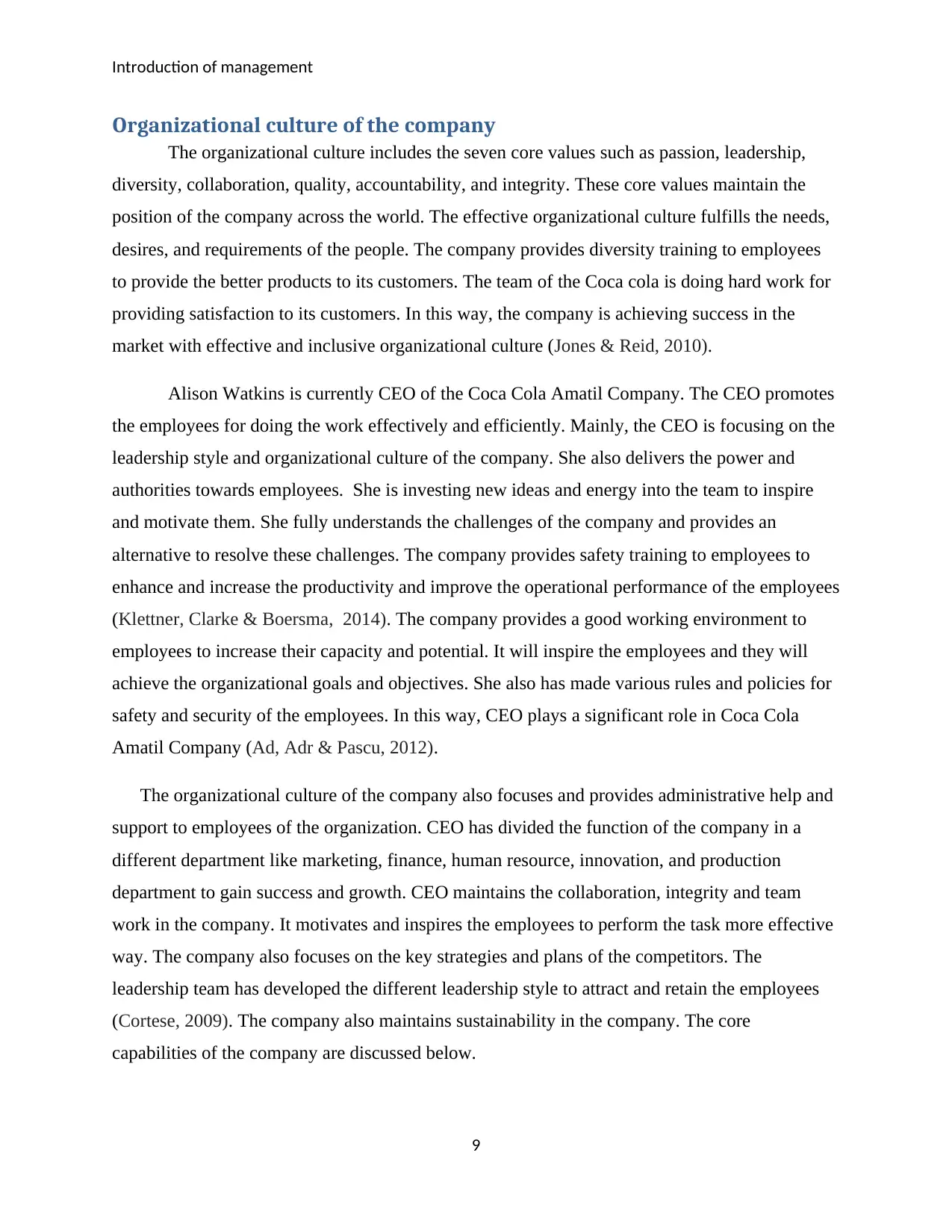
Introduction of management
Organizational culture of the company
The organizational culture includes the seven core values such as passion, leadership,
diversity, collaboration, quality, accountability, and integrity. These core values maintain the
position of the company across the world. The effective organizational culture fulfills the needs,
desires, and requirements of the people. The company provides diversity training to employees
to provide the better products to its customers. The team of the Coca cola is doing hard work for
providing satisfaction to its customers. In this way, the company is achieving success in the
market with effective and inclusive organizational culture (Jones & Reid, 2010).
Alison Watkins is currently CEO of the Coca Cola Amatil Company. The CEO promotes
the employees for doing the work effectively and efficiently. Mainly, the CEO is focusing on the
leadership style and organizational culture of the company. She also delivers the power and
authorities towards employees. She is investing new ideas and energy into the team to inspire
and motivate them. She fully understands the challenges of the company and provides an
alternative to resolve these challenges. The company provides safety training to employees to
enhance and increase the productivity and improve the operational performance of the employees
(Klettner, Clarke & Boersma, 2014). The company provides a good working environment to
employees to increase their capacity and potential. It will inspire the employees and they will
achieve the organizational goals and objectives. She also has made various rules and policies for
safety and security of the employees. In this way, CEO plays a significant role in Coca Cola
Amatil Company (Ad, Adr & Pascu, 2012).
The organizational culture of the company also focuses and provides administrative help and
support to employees of the organization. CEO has divided the function of the company in a
different department like marketing, finance, human resource, innovation, and production
department to gain success and growth. CEO maintains the collaboration, integrity and team
work in the company. It motivates and inspires the employees to perform the task more effective
way. The company also focuses on the key strategies and plans of the competitors. The
leadership team has developed the different leadership style to attract and retain the employees
(Cortese, 2009). The company also maintains sustainability in the company. The core
capabilities of the company are discussed below.
9
Organizational culture of the company
The organizational culture includes the seven core values such as passion, leadership,
diversity, collaboration, quality, accountability, and integrity. These core values maintain the
position of the company across the world. The effective organizational culture fulfills the needs,
desires, and requirements of the people. The company provides diversity training to employees
to provide the better products to its customers. The team of the Coca cola is doing hard work for
providing satisfaction to its customers. In this way, the company is achieving success in the
market with effective and inclusive organizational culture (Jones & Reid, 2010).
Alison Watkins is currently CEO of the Coca Cola Amatil Company. The CEO promotes
the employees for doing the work effectively and efficiently. Mainly, the CEO is focusing on the
leadership style and organizational culture of the company. She also delivers the power and
authorities towards employees. She is investing new ideas and energy into the team to inspire
and motivate them. She fully understands the challenges of the company and provides an
alternative to resolve these challenges. The company provides safety training to employees to
enhance and increase the productivity and improve the operational performance of the employees
(Klettner, Clarke & Boersma, 2014). The company provides a good working environment to
employees to increase their capacity and potential. It will inspire the employees and they will
achieve the organizational goals and objectives. She also has made various rules and policies for
safety and security of the employees. In this way, CEO plays a significant role in Coca Cola
Amatil Company (Ad, Adr & Pascu, 2012).
The organizational culture of the company also focuses and provides administrative help and
support to employees of the organization. CEO has divided the function of the company in a
different department like marketing, finance, human resource, innovation, and production
department to gain success and growth. CEO maintains the collaboration, integrity and team
work in the company. It motivates and inspires the employees to perform the task more effective
way. The company also focuses on the key strategies and plans of the competitors. The
leadership team has developed the different leadership style to attract and retain the employees
(Cortese, 2009). The company also maintains sustainability in the company. The core
capabilities of the company are discussed below.
9
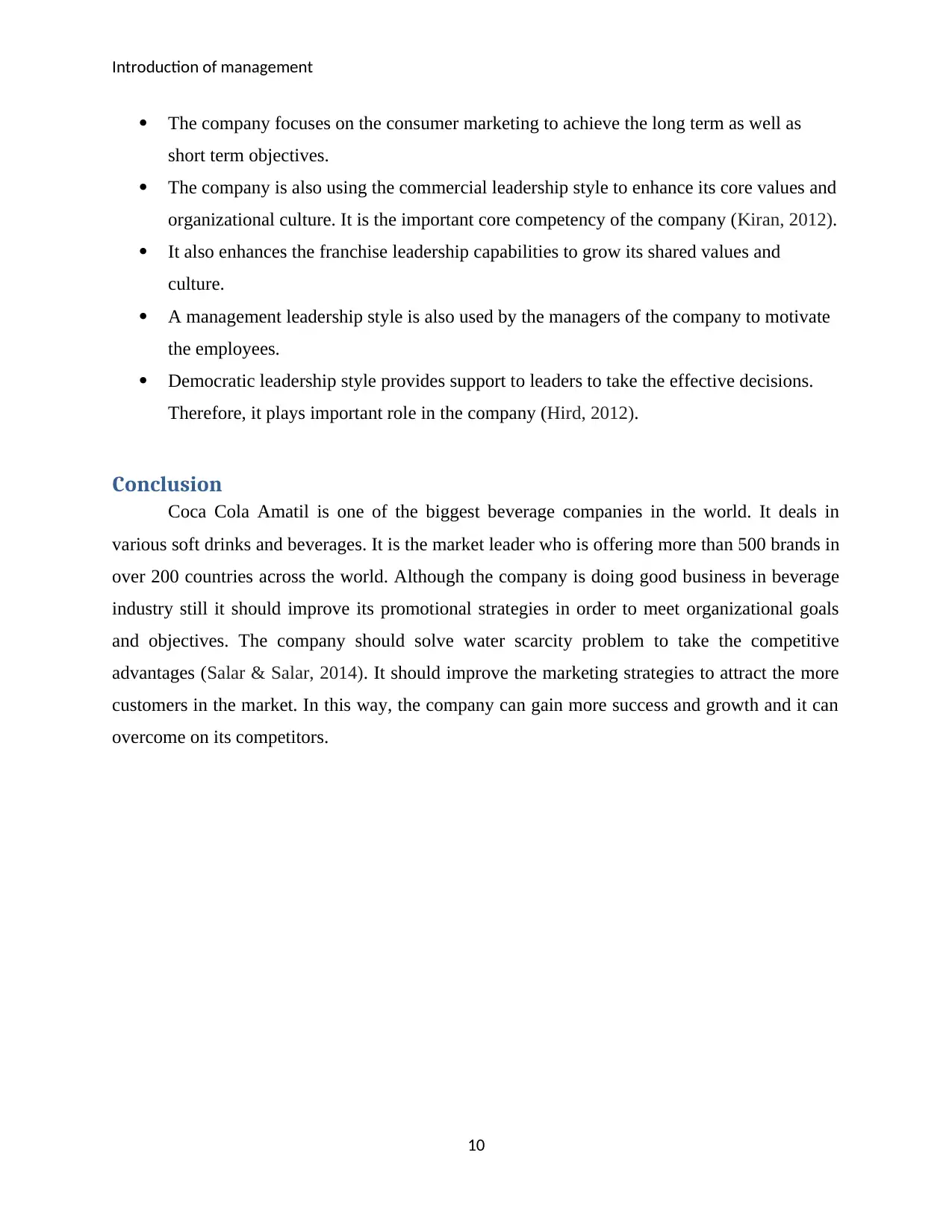
Introduction of management
The company focuses on the consumer marketing to achieve the long term as well as
short term objectives.
The company is also using the commercial leadership style to enhance its core values and
organizational culture. It is the important core competency of the company (Kiran, 2012).
It also enhances the franchise leadership capabilities to grow its shared values and
culture.
A management leadership style is also used by the managers of the company to motivate
the employees.
Democratic leadership style provides support to leaders to take the effective decisions.
Therefore, it plays important role in the company (Hird, 2012).
Conclusion
Coca Cola Amatil is one of the biggest beverage companies in the world. It deals in
various soft drinks and beverages. It is the market leader who is offering more than 500 brands in
over 200 countries across the world. Although the company is doing good business in beverage
industry still it should improve its promotional strategies in order to meet organizational goals
and objectives. The company should solve water scarcity problem to take the competitive
advantages (Salar & Salar, 2014). It should improve the marketing strategies to attract the more
customers in the market. In this way, the company can gain more success and growth and it can
overcome on its competitors.
10
The company focuses on the consumer marketing to achieve the long term as well as
short term objectives.
The company is also using the commercial leadership style to enhance its core values and
organizational culture. It is the important core competency of the company (Kiran, 2012).
It also enhances the franchise leadership capabilities to grow its shared values and
culture.
A management leadership style is also used by the managers of the company to motivate
the employees.
Democratic leadership style provides support to leaders to take the effective decisions.
Therefore, it plays important role in the company (Hird, 2012).
Conclusion
Coca Cola Amatil is one of the biggest beverage companies in the world. It deals in
various soft drinks and beverages. It is the market leader who is offering more than 500 brands in
over 200 countries across the world. Although the company is doing good business in beverage
industry still it should improve its promotional strategies in order to meet organizational goals
and objectives. The company should solve water scarcity problem to take the competitive
advantages (Salar & Salar, 2014). It should improve the marketing strategies to attract the more
customers in the market. In this way, the company can gain more success and growth and it can
overcome on its competitors.
10
Secure Best Marks with AI Grader
Need help grading? Try our AI Grader for instant feedback on your assignments.
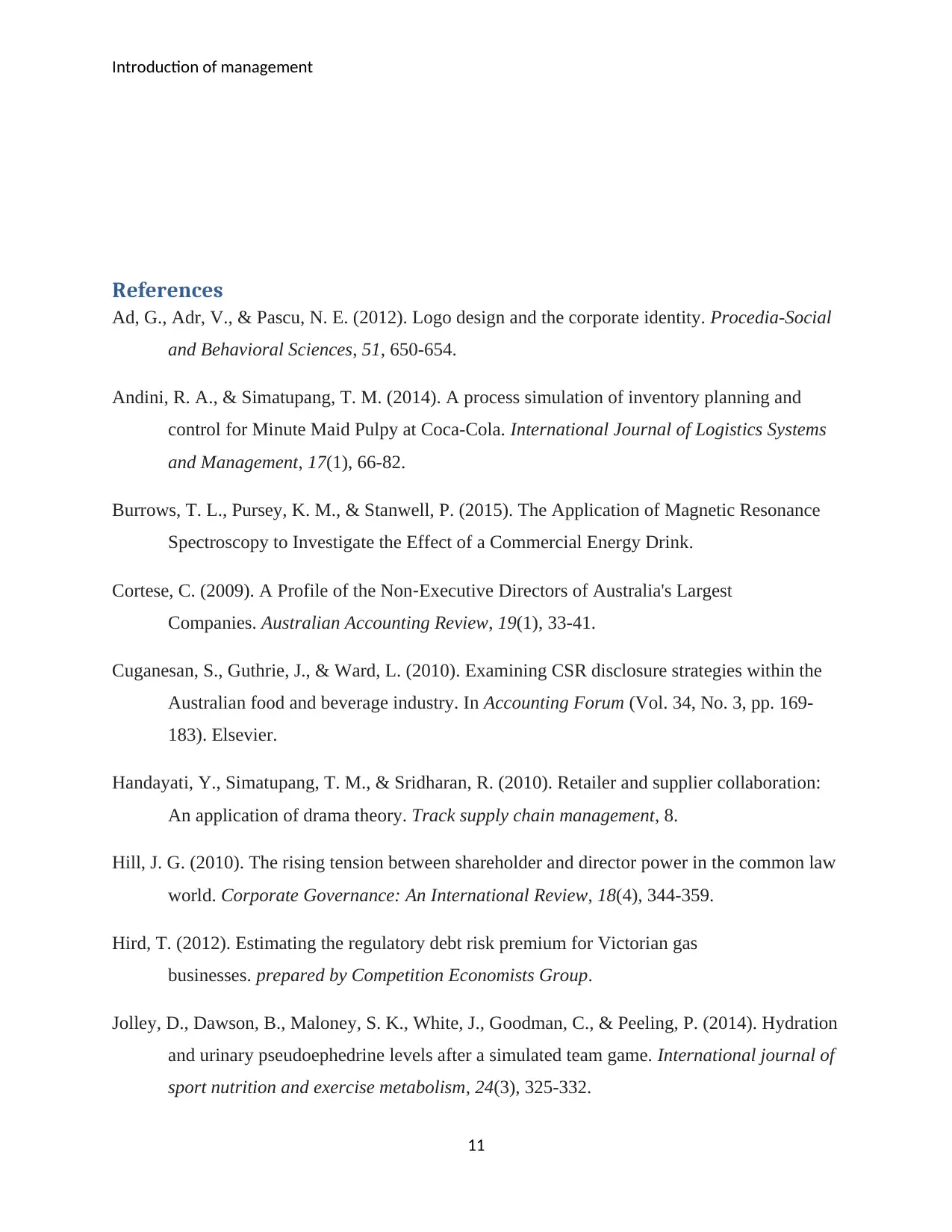
Introduction of management
References
Ad, G., Adr, V., & Pascu, N. E. (2012). Logo design and the corporate identity. Procedia-Social
and Behavioral Sciences, 51, 650-654.
Andini, R. A., & Simatupang, T. M. (2014). A process simulation of inventory planning and
control for Minute Maid Pulpy at Coca-Cola. International Journal of Logistics Systems
and Management, 17(1), 66-82.
Burrows, T. L., Pursey, K. M., & Stanwell, P. (2015). The Application of Magnetic Resonance
Spectroscopy to Investigate the Effect of a Commercial Energy Drink.
Cortese, C. (2009). A Profile of the Non‐Executive Directors of Australia's Largest
Companies. Australian Accounting Review, 19(1), 33-41.
Cuganesan, S., Guthrie, J., & Ward, L. (2010). Examining CSR disclosure strategies within the
Australian food and beverage industry. In Accounting Forum (Vol. 34, No. 3, pp. 169-
183). Elsevier.
Handayati, Y., Simatupang, T. M., & Sridharan, R. (2010). Retailer and supplier collaboration:
An application of drama theory. Track supply chain management, 8.
Hill, J. G. (2010). The rising tension between shareholder and director power in the common law
world. Corporate Governance: An International Review, 18(4), 344-359.
Hird, T. (2012). Estimating the regulatory debt risk premium for Victorian gas
businesses. prepared by Competition Economists Group.
Jolley, D., Dawson, B., Maloney, S. K., White, J., Goodman, C., & Peeling, P. (2014). Hydration
and urinary pseudoephedrine levels after a simulated team game. International journal of
sport nutrition and exercise metabolism, 24(3), 325-332.
11
References
Ad, G., Adr, V., & Pascu, N. E. (2012). Logo design and the corporate identity. Procedia-Social
and Behavioral Sciences, 51, 650-654.
Andini, R. A., & Simatupang, T. M. (2014). A process simulation of inventory planning and
control for Minute Maid Pulpy at Coca-Cola. International Journal of Logistics Systems
and Management, 17(1), 66-82.
Burrows, T. L., Pursey, K. M., & Stanwell, P. (2015). The Application of Magnetic Resonance
Spectroscopy to Investigate the Effect of a Commercial Energy Drink.
Cortese, C. (2009). A Profile of the Non‐Executive Directors of Australia's Largest
Companies. Australian Accounting Review, 19(1), 33-41.
Cuganesan, S., Guthrie, J., & Ward, L. (2010). Examining CSR disclosure strategies within the
Australian food and beverage industry. In Accounting Forum (Vol. 34, No. 3, pp. 169-
183). Elsevier.
Handayati, Y., Simatupang, T. M., & Sridharan, R. (2010). Retailer and supplier collaboration:
An application of drama theory. Track supply chain management, 8.
Hill, J. G. (2010). The rising tension between shareholder and director power in the common law
world. Corporate Governance: An International Review, 18(4), 344-359.
Hird, T. (2012). Estimating the regulatory debt risk premium for Victorian gas
businesses. prepared by Competition Economists Group.
Jolley, D., Dawson, B., Maloney, S. K., White, J., Goodman, C., & Peeling, P. (2014). Hydration
and urinary pseudoephedrine levels after a simulated team game. International journal of
sport nutrition and exercise metabolism, 24(3), 325-332.
11
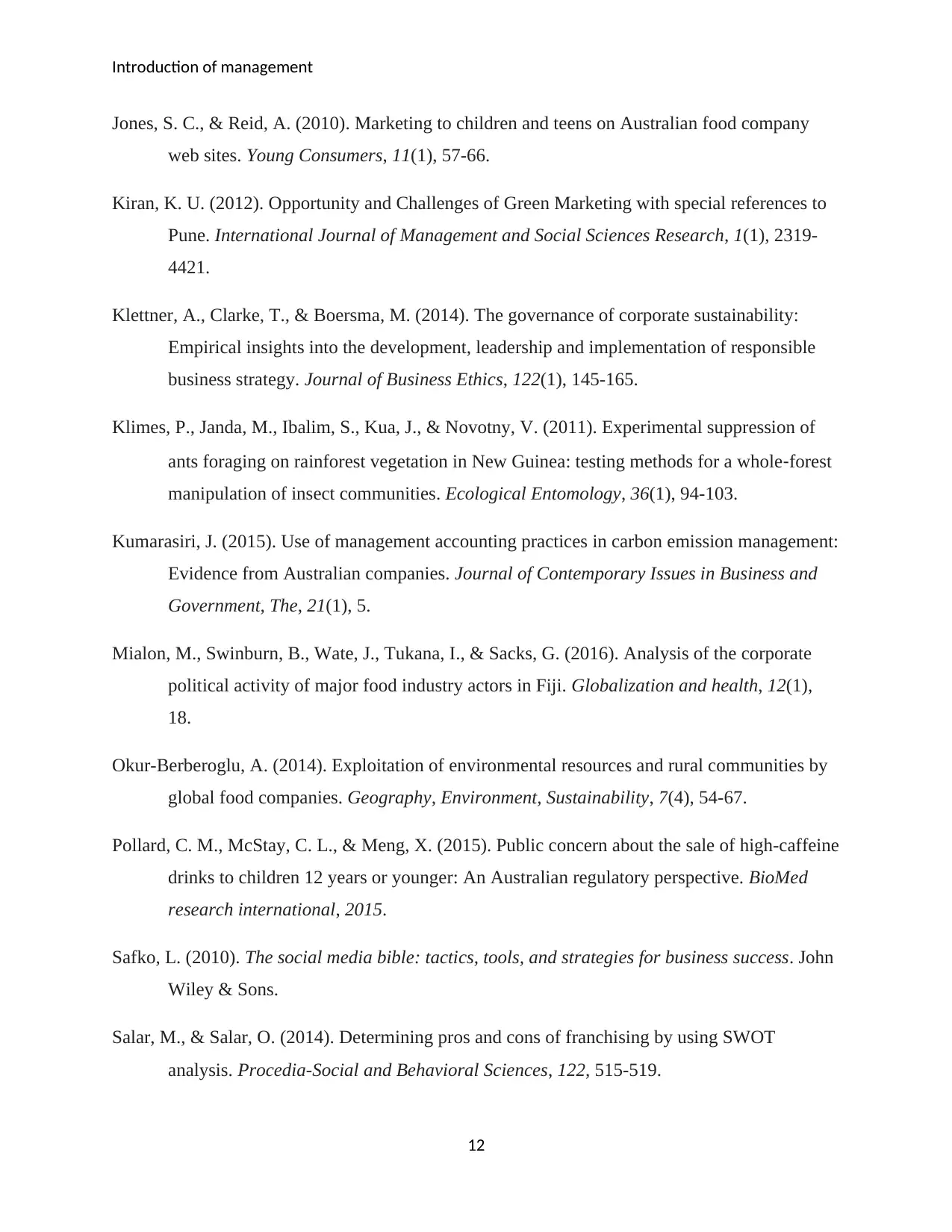
Introduction of management
Jones, S. C., & Reid, A. (2010). Marketing to children and teens on Australian food company
web sites. Young Consumers, 11(1), 57-66.
Kiran, K. U. (2012). Opportunity and Challenges of Green Marketing with special references to
Pune. International Journal of Management and Social Sciences Research, 1(1), 2319-
4421.
Klettner, A., Clarke, T., & Boersma, M. (2014). The governance of corporate sustainability:
Empirical insights into the development, leadership and implementation of responsible
business strategy. Journal of Business Ethics, 122(1), 145-165.
Klimes, P., Janda, M., Ibalim, S., Kua, J., & Novotny, V. (2011). Experimental suppression of
ants foraging on rainforest vegetation in New Guinea: testing methods for a whole‐forest
manipulation of insect communities. Ecological Entomology, 36(1), 94-103.
Kumarasiri, J. (2015). Use of management accounting practices in carbon emission management:
Evidence from Australian companies. Journal of Contemporary Issues in Business and
Government, The, 21(1), 5.
Mialon, M., Swinburn, B., Wate, J., Tukana, I., & Sacks, G. (2016). Analysis of the corporate
political activity of major food industry actors in Fiji. Globalization and health, 12(1),
18.
Okur-Berberoglu, A. (2014). Exploitation of environmental resources and rural communities by
global food companies. Geography, Environment, Sustainability, 7(4), 54-67.
Pollard, C. M., McStay, C. L., & Meng, X. (2015). Public concern about the sale of high-caffeine
drinks to children 12 years or younger: An Australian regulatory perspective. BioMed
research international, 2015.
Safko, L. (2010). The social media bible: tactics, tools, and strategies for business success. John
Wiley & Sons.
Salar, M., & Salar, O. (2014). Determining pros and cons of franchising by using SWOT
analysis. Procedia-Social and Behavioral Sciences, 122, 515-519.
12
Jones, S. C., & Reid, A. (2010). Marketing to children and teens on Australian food company
web sites. Young Consumers, 11(1), 57-66.
Kiran, K. U. (2012). Opportunity and Challenges of Green Marketing with special references to
Pune. International Journal of Management and Social Sciences Research, 1(1), 2319-
4421.
Klettner, A., Clarke, T., & Boersma, M. (2014). The governance of corporate sustainability:
Empirical insights into the development, leadership and implementation of responsible
business strategy. Journal of Business Ethics, 122(1), 145-165.
Klimes, P., Janda, M., Ibalim, S., Kua, J., & Novotny, V. (2011). Experimental suppression of
ants foraging on rainforest vegetation in New Guinea: testing methods for a whole‐forest
manipulation of insect communities. Ecological Entomology, 36(1), 94-103.
Kumarasiri, J. (2015). Use of management accounting practices in carbon emission management:
Evidence from Australian companies. Journal of Contemporary Issues in Business and
Government, The, 21(1), 5.
Mialon, M., Swinburn, B., Wate, J., Tukana, I., & Sacks, G. (2016). Analysis of the corporate
political activity of major food industry actors in Fiji. Globalization and health, 12(1),
18.
Okur-Berberoglu, A. (2014). Exploitation of environmental resources and rural communities by
global food companies. Geography, Environment, Sustainability, 7(4), 54-67.
Pollard, C. M., McStay, C. L., & Meng, X. (2015). Public concern about the sale of high-caffeine
drinks to children 12 years or younger: An Australian regulatory perspective. BioMed
research international, 2015.
Safko, L. (2010). The social media bible: tactics, tools, and strategies for business success. John
Wiley & Sons.
Salar, M., & Salar, O. (2014). Determining pros and cons of franchising by using SWOT
analysis. Procedia-Social and Behavioral Sciences, 122, 515-519.
12
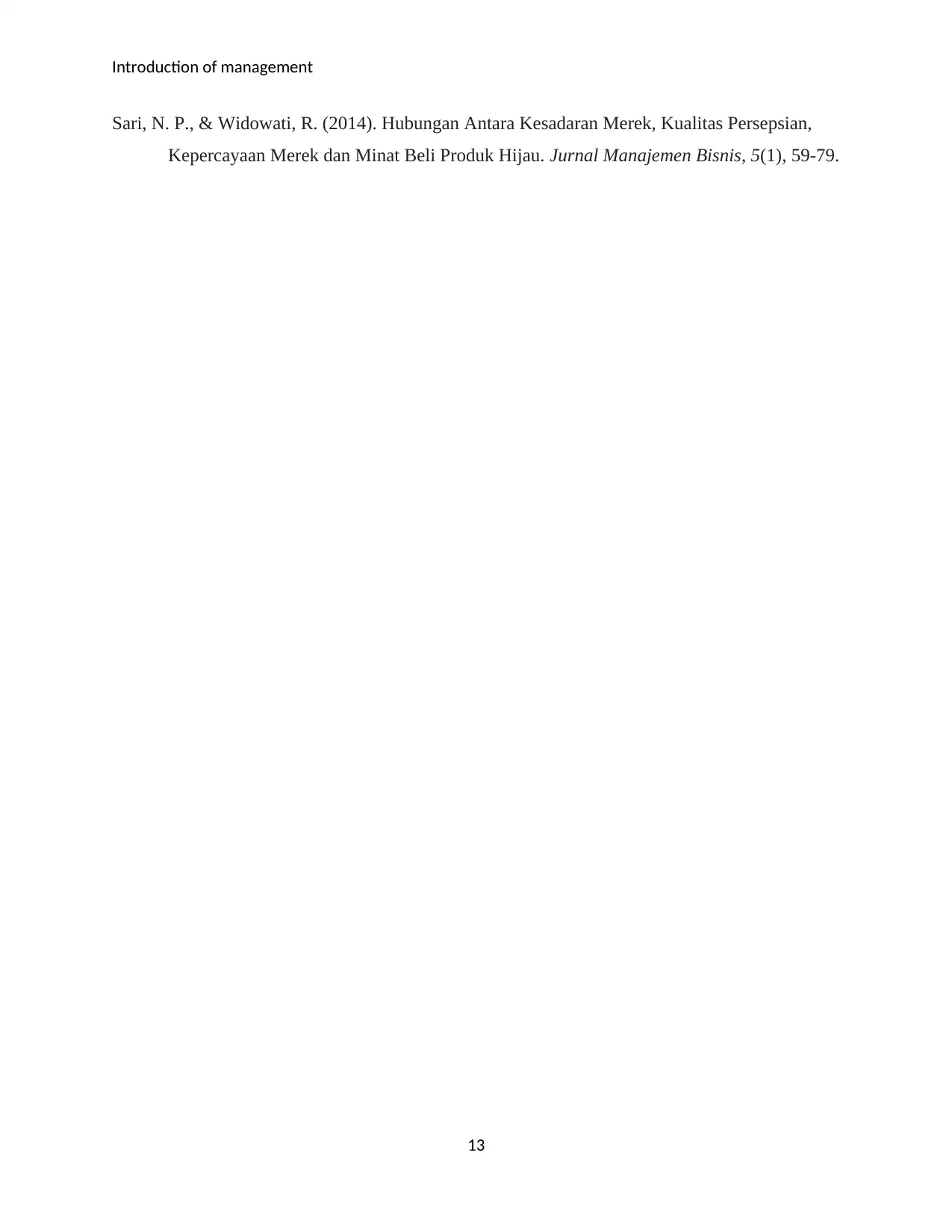
Introduction of management
Sari, N. P., & Widowati, R. (2014). Hubungan Antara Kesadaran Merek, Kualitas Persepsian,
Kepercayaan Merek dan Minat Beli Produk Hijau. Jurnal Manajemen Bisnis, 5(1), 59-79.
13
Sari, N. P., & Widowati, R. (2014). Hubungan Antara Kesadaran Merek, Kualitas Persepsian,
Kepercayaan Merek dan Minat Beli Produk Hijau. Jurnal Manajemen Bisnis, 5(1), 59-79.
13
1 out of 13
Related Documents
Your All-in-One AI-Powered Toolkit for Academic Success.
+13062052269
info@desklib.com
Available 24*7 on WhatsApp / Email
![[object Object]](/_next/static/media/star-bottom.7253800d.svg)
Unlock your academic potential
© 2024 | Zucol Services PVT LTD | All rights reserved.





